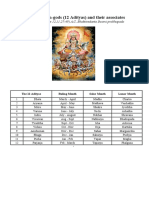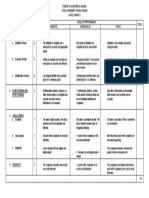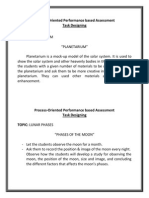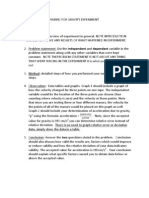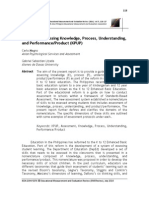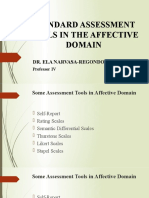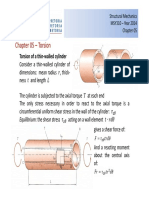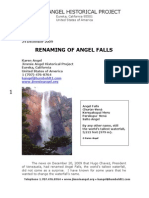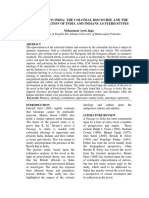GRASPS Examples
GRASPS Examples
Uploaded by
Christine MercedeCopyright:
Available Formats
GRASPS Examples
GRASPS Examples
Uploaded by
Christine MercedeOriginal Description:
Copyright
Available Formats
Share this document
Did you find this document useful?
Is this content inappropriate?
Copyright:
Available Formats
GRASPS Examples
GRASPS Examples
Uploaded by
Christine MercedeCopyright:
Available Formats
UbD Design Guide Worksheets - MOD M
Figure M. 04 Performance Task Scenario
(G.R.A.S.P.S. - Nutrition example)
Goal:
The goal (within the scenario) is to create an illustrated brochure to teach
the 2nd graders about the importance of good nutrition for healthful living
Role:
You are a teacher of nutrition
Audience:
The target audience is a 2nd grade class
Situation:
You need to. show the difference between a balanced diet and an unhealthy diet.
Product/Performance and Purpose:
You need to create a brochure that describes helathy vs unhealthy eating and shows at least 2 health problems that can occur as a result of poor eating.
Standards & Criteria for Success:
Your brochure should...
- contain accurate information
- easy for 2nd graders to read and understand
Wiggins & McTighe 2008
page 1
UbD Design Guide Worksheets - MOD M
Figure M. 05 Performance Task Scenario
(G.R.A.S.P.S. - Nutrition example TASK #2)
Goal:
The goal is to create a menu for the 3-day trip to the Outdoor Ed. Center.
Role:
You are a menu advisor
Audience:
The target audience The Outdoor Center Director (and your
peers)
Situation:
You need to propose a nutrtionally-balanced and tasy menu, within budfget, for 3 days of camping by the entire class.
Product/Performance and Purpose:
Menu plan for three days, including the 3 main meals and 3 snacks (a.m., p.m., and
campfire).
Letter to the director explaining how your menu meets the USDA nutritional guidelines. Include a chart showing a breakdown of the fat, protein, carbohydrates, vitamins,
minerals, and calories. Explain how you made it as tasty as possible.
Standards & Criteria for Success:
healthy and tasty menu
well written and well supported letter.
Wiggins & McTighe 2008
page 2
UbD Design Guide Worksheets - MOD M
Figure M. 06 Performance Task Scenario
(G.R.A.S.P.S. - mathematics example)
Goal:
The goal (within the scenario) is to minimize costs for shipping
bulk quantities of M&Ms.
Role:
You are an engineer in the packaging department of the M&M
Candy Company.
Audience:
The target audience is non-engineer company executives.
Situation:
You need to convince penny-pinching company officers that your
container design will provide cost-effective use of the given
materials, maximize shipping volume of bulk quantities of M&Ms,
and be safe to transport.
Product/Performance and Purpose:
You need to design a shipping container from given materials
for the safe and cost-effective shipping of the M&Ms. Then you
will prepare a written proposal in which you include a diagram and
show mathematically how your container design provides effective
use of the given materials and maximizes the shipping volume of
the M&Ms.
Standards & Criteria for Success:
Your container proposal should...
- provide cost-effective use of the given materials
- maximize shipping volume of bulk quantities of M&Ms
- be safe to transport
Your models must make the mathematical case.
Wiggins & McTighe 2008
page 3
UbD Design Guide Worksheets - MOD M
Figure M.07 Performance Task Scenario
(G.R.A.S.P.S. - social studies example)
Goal:
Your goal is to help a group of foreign visitors understand the
key historic, geographic and economic features of our region.
Role:
You are an intern at the Regional Office of Tourism.
Audience:
The audience is a group of nine foreign visitors (who speak
English).
Situation:
You have been asked to develop a plan, including a budget, for
a four-day tour of the region. Plan your tour so that the visitors
are shown sites that best illustrate the key historical, geographic
and economic features of our region.
Product/Performance and Purpose:
You need to prepare a written tour itinerary and a budget for
the trip. You should include an explanation of why each site was
selected and how it will help the visitors understand the key
historic, geographic and economic features of our region. Include
a map tracing the route for the tour.
[Optional: Provide a budget for the trip.]*
Standards & Criteria for Success:
Your proposed tour plan needs to include...
- an itinerary and route map
- the key historical, geographic and economic features
of the region
- a clear rationale for the selected sites
*- accurate and complete budget figures
Wiggins & McTighe 2008
page 4
UbD Design Guide Worksheets - MOD M
Figure M.08 Task Scenario Builder
(G.R.A.S.P.S.)
Consider the following set of stem statements as you construct a scenario for a performance task.
Refer to the previous idea sheets to help you brainstorm possible scenarios. (Note: These are idea
starters. Resist the urge to fill in all of the blanks.)
Goal :
Your task is ________________________________________________________________________
The goal is to _______________________________________________________________________
The problem/challenge is______________________________________________________________
The obstacle(s) to overcome is (are) _____________________________________________________
Role:
You are ___________________________________________________________________________
You have been asked to _______________________________________________________________
Your job is ________________________________________________________________________
Audience:
Your client(s) is (are) ________________________________________________________________
The target audience is _ ______________________________________________________________
You need to convince ________________________________________________________________
Situation:
The context you find yourself in is ______________________________________________________
The challenge involves dealing with _ ___________________________________________________
Product/Performance and Purpose:
You will create a ____________________________________________________________________
in order to _________________________________________________________________________
You need to develop _________________________________________________________________
so that ____________________________________________________________________________
Standards & Criteria for Success:
Your performance needs to ____________________________________________________________
Your work will be judged by __________________________________________________________
Your product must meet the following standards ___________________________________________
A successful result will _______________________________________________________________
Wiggins & McTighe 2008
page 5
UbD Design Guide Worksheets - MOD M
Figure M.09 Alternate Task Starter
Scenario
You are a curator of a US History museum.
Design a museum exhibit on prairie life containing
drawings, simulated diary entries, and pioneer letters
back home. The goal of your exhibit is to inform
visitors about the challenges faced by the pioneers.
Your exhibit should...
meet the following criteria:
4
accurate
appropriate apt clear convincing correct creative defensible effective efficient
elegant empathetic entertaining justified
4informative insightful novel organized
perceptive persuasive polished precise
proficient reflective responsive revealing sensitive skilled sophisticated supported
4
thorough well-crafted
understandable unique
valid verified other: ________________________
so that:
the museum visitors better understand the dangers
and hardships and of pioneer life on the prairie
Wiggins & McTighe 2008
page 6
UbD Design Guide Worksheets - MOD M
Figure M.10 Alternate Approach to Tasks
Scenario
Design an experiment to determine which of four
brands of detergent will most
effectively remove
three different types of stains on cotton fabric.
Provide written directions and a graphic display to
guide an absent classmate through your procedure.
Your experimental procedure should...
meet the following criteria:
4convincaccurate appropriate apt clear
4
ing correct
creative defensible effective efficient
elegant empathetic entertaining justified
informative insightful novel organized
4
perceptive persuasive polished
precise
proficient reflective responsive revealing sensitive skilled sophisticated supported
4
thorough
well-crafted understandable unique
valid verified other: ________________________
so that:
another experimenter can follow your procedure
and determine the most effective detergent for
removing each stain
Wiggins & McTighe 2008
page 7
UbD Design Guide Worksheets - MOD M
Figure M. 11 - Ideas for Performance Tasks
The life of pioneers on the prairie was filled with
hardships and dangers.
walk in the shoes of...
entertain the possibility that...
4
adjust reflect
upon revise
self assess recognize their habit
Wiggins & McTighe 2008
letters, diaries and photographs
for insights into the hardships
of prairie life
4
empathize with imagine
others about the hardships and
dangers of pioneer life
a museum exhibit to reveal how
the life of pioneers on the
prairie was filled with hardships
and dangers
4compare critique debate
evaluate shift perspective
test consider the various views
why people leave home - then
versus now
Apply
create construct de-bug
4design demonstrate
decide
guide use perform
propose coach solve
why/how/that/the/of...
the suffering and the courage of
the pioneers
Explain
Interpret
analyze illustrate interpret
4reveal
make sense of...
represent show
Self
Assess
connect describe explain
4 inform prove persuade
teach show justify
Shift
Perspective
when they can:
Empathize
Students show they
understand that:
how much harder life was then
as compared to today
page 8
UbD Design Guide Worksheets - MOD M
Figure M. 12 STUDENT ROLES and AUDIENCKEY: ROLES = and AUDIENCES =
actor
advertiser
artist/illustrator
author
biographer
board member
boss
boy/girl scout
businessperson
candidate
carpenter
cartoon character
cartoonist
caterer
celebrity
chairperson
chef
choreographer
CEO
coach
community members
composer
clients/customer
construction worker
dancer
designer
detective
editor
elected official
embassy staff
engineer
expert (in ________)
eye witness
Wiggins & McTighe 2008
family member
farmer
filmmaker
firefighter
forest ranger
friend
geologist
government official
historian
historical figure
illustrator
intern
interviewer
inventor
judge
jury
lawyer
library patron
literary critic
lobbyist
meteorologist
museum director/
curator
museum goer
neighbor
newscaster
novelist
nutritionist
panelist
parent
park ranger
pen pal
photographer
pilot
playwright
poet
policeman/woman
pollster
radio listener
reader
reporter
researcher
reviewer
sailor
school official
scientist
ships captain
social scientist
social worker
statistician
storyteller
student
taxi driver
teacher
t.v. viewer
tour guide
trainer
travel agent
traveler
t.v./movie
character
tutor
viewer
visitor
website designer
zoo keeper
page 9
UbD Design Guide Worksheets - MOD M
Figure M. 13
Possible Products and Performances
What student product(s) and/or performance(s) will provide appropriate evidence of understanding
and/or proficiency? The following lists offer possibilities. (Remember that student products and
performances should be framed by an explicit purpose or goal and an identified audience.)
Written
Oral
advertisement
audiotape
biography
conversation
book report/review debate
brochure
discussion
collection
dramatization
crossword puzzle
dramatic reading
editorial
interview
essay
radio script
experiment record
oral presentation
historical fiction
oral report
journal
poetry reading
lab report
puppet show
letter
rap
log
skit
magazine article
speech
memo
song
newscast
teach a lesson
newspaper article
play
poem
position paper
proposal
research report
script
story
other: _______________
test
web site
other: _______________
Wiggins & McTighe 2008
Visual
advertisement
banner
cartoon
collage
computer graphic
data display
design
diagram
diorama
display
drawing
filmstrip
flyer
game
graph
map
model
Power Point show
photograph
questionnaire
painting
poster
scrapbook
sculpture
slide show
storyboard
videotape
web site
page 10
UbD Design Guide Worksheets - MOD M
M. 16 A Collection of Assessment Evidence
(example - unit on Nutrition - grades 5-6)
Performance Tasks:
You Are What You Eat Students create an illustrated
brochure to teach younger children about the importance
of good nutrition for healthful living.
Chow Down Students develop a 3-day menu for meals and
snacks for an upcoming Outdoor Education camp experience.
They write a letter to the camp director to explain why
their menu should be selected (by showing that it meets the
USDA Food Pyramid recommendations, yet tasty enough for
the students).
Other Evidence:
(e.g., tests, quizzes, prompts, work samples, observations, etc.)
Quiz 1 - the food groups
OE
Quiz 2 - the USDA Food Pyramid
Prompt - Describe two health problems that could arise as
a result of poor nutrition and explain how these could be
avoided.
Student Self-Assessment and Reflection:
SA
1. self assess the brochure, You are What You Eat
2. self assess the camp menu, Chow Down
3. self assess the extent to which you eat healthy at the
end of unit (compared to the beginning)
Wiggins & McTighe 2008
page 11
Wiggins & McTighe 2008
then, the assessments below match up
with the desired result(s) by number:
Stage 2
Note: there need not be a 1-to-1 correspondence. Some desired results will be
assessed by more than one assessment and vice versa.
If the desired results require learners
to understand, address Essential Questions, know, and be able to do...
Stage 1
UbD Design Guide Worksheets - MOD M
M. 17 Check: Is every desired result assessed?
For every desired result, you need one or more assessments. Use the sheet below to identify the
corresponding number(s) of each STAGE 1 element next to the assessment(s) designed to provide
evidence of it.
page 12
UbD Design Guide Worksheets - MOD M
Figure M. 18 - Design Checklist Stage 2
Performance Task(s)
1. _____ The performance task(s) in Box T is/are aligned with one or more desired
results in Stage 1. The task(s) will yield appropriate evidence of the
identified understanding(s).
2. _____ The task(s) involve(s) a complex, real-world (i.e., authentic) application of
the identified knowledge, skill, and understandings.
3. _____ The task(s) is/are written in the G.R.A.S.P.S. form.
4. _____ The task(s) allow(s) students to demonstrate understanding with some
choice/options/variety in the performances and/or products.
5. _____ The task(s) are not likely to be performed well without a clear grasp of the
understandings the task is meant to assess.
6. _____ The task(s) require(s) one or more of the six facets of understandings.
7. _____ The scoring rubric(s) include(s) distinct traits of understanding and successful performance.
8. _____ The scoring rubric(s) highlight what is appropriate, given the evidence needs
suggested by the Desired Results of Stage 1.
Other Evidence
OE
9. _____ Other appropriate evidence has been identified in summary form (e.g., key
quizzes, exams, student self-assessments, etc.) to supplement the evidence
provided by the performance task(s) .
10. _____ Students are given the opportunity to self-assess and reflect upon their
learning and performance.
Wiggins & McTighe 2008
page 13
UbD Design Guide Worksheets - MOD M
FIGURE M. 19 ASSESSMENT TIPS & GUIDELINES
Determine acceptable evidence.
What evidence will show that students understand and can meet other unit goals?
Performance Tasks:
A performance task
o Requires transfer i.e. a repertoire of knowledge and skill to be used wisely and
effectively in a new situation - i.e. used with understanding
o Asks students to do the subject, not just recall and plug in discrete learning, out
of context
o Is set in a novel situation, with little or no scaffolding or cues provided: the student
has to think through what the task demands as part of the assessment (the game
vs. the scaffolded and simplified drills)
o should be as realistic as possible, in which students confront the same kinds of challenges, constraints, and options found in the real world
A task, like any other aspect of STAGE 2, is meant to yield evidence of key elements in
Stage 1; it is not meant to be a learning activity: validity is the primary concern, not whether it is interesting or fun as a task.
A performance task may actually involve a variety of situations, performances, and products (i.e. it can be a complex task, with related sub-tasks).
Writing the task in GRASPS form makes it likely that the task will involve authentic transfer: give the student a Goal, a Role, an Audience, a Setting, Performance/product demands,
and a set of Standards and criteria by which work will be judged.
Build in as much differentiation via options and alternatives in the situation(s) as is feasible without corrupting the validity of the assessment. (i.e. the various options should be
relatively equal in what they demand and reveal about a students understanding.)
The goal is sufficient evidence for each student. Any group component to a task should be
matched by evidence about the individuals understanding. This can be accomplished by
having separate parts to the task (such as a separate sub-task in which roles and perspective
change e.g. from group design team to solo reviewer) or by quizzes and prompts given to
each student (and put in Other Evidence) that assess for the same goals.
Dont end up unwittingly assessing for evidence unrelated to your goals. Keep asking the
2-question validity test and its implications: can the task be done well without understanding? Can the task be done poorly by someone with deep understanding? Then, the
task will not yield valid evidence, by definition. Be especially careful of demanding a mode
or method of assessment that favors some student ability over others in ways that are not at
the heart of your goals, e.g. you end up assessing - unfairly - writing ability or multimedia
facility instead of understanding of the subject.
Wiggins & McTighe 2008
page 14
UbD Design Guide Worksheets - MOD M
M. 19 ASSESSMENT DESIGN TIPS & GUIDELINES
Stage 2: Determine acceptable evidence.
Rubric(s):
Clarify the criteria by which constructed-response work should be judged, and develop
rubrics for each continuum of quality. It doesnt matter whether you have a single rubric
in a matrix form for the various traits or separate pages for each rubric related to each
criterion. What matters is that you assess all the independent variables central to success.
Use as many distinct criteria as needed to ensure excellent feedback. Rule of thumb: the
fewest independent variables. e.g. accuracy is independent of well-developed and
creative so that at least those three criteria should be assessed separately.
Make sure that you identify valid criteria for scoring that suit the transfer goals and
understandings, not just the particulars of the performance tasks (e.g. if the Standard
involves causes and effects of the Civil War, score causal reasoning and insight of
historical analysis not just high-quality museum display)
Other Evidence (quizzes, tests, prompts, observations, dialogues, etc.):
Identify the specific questions related to key knowledge and skill goals from Stage 1 that
you expect students to be able to answer upon completion of this unit.
Typical tests, quizzes, and homework belong in this box: discrete and uncomplicated assessment of skills and factual knowledge that isnt otherwise assessed in the performance
tasks.
Supplement all your performance tasks, as needed, to get more reliable and varied evidence
of understanding, knowledge, and skill for each individual student. This is especially important if you claim that this unit addresses a Standard in an in-depth way, and the performance tasks are basically group projects. You need evidence for each student, ultimately.
The goal is a photo album, not a single snapshot, for the assessments in the unit to be both valid and
reliable.
Dont confuse assessment evidence with giving grades. Just because you plan to assess
it doesnt mean you will give a grade to it. Nor does the assessment score need to translate mechanically into a grade. If the task is difficult and new for students, then grade
accordingly; if the point of the assessment is more for feedback, then dont make it a grade
for achievement, only process and effort, etc. This is not to say: dont give grades. It is to
say: dont confuse feedback to students with the separate act of giving grades. [Local
grading policy may be in need for discussion and revision as a separate issue.]
Wiggins & McTighe 2008
page 15
You might also like
- Sample Contract-Of-Lease - BlankDocument5 pagesSample Contract-Of-Lease - BlankChristine Mercede100% (1)
- I'M Still Standing: mLY""""I"""""'TJOHAL.I1 "Document40 pagesI'M Still Standing: mLY""""I"""""'TJOHAL.I1 "Rayane Rkg100% (5)
- Section 3Document36 pagesSection 3mica67% (3)
- Grasps Model Performance TaskDocument4 pagesGrasps Model Performance TaskCatherine Paguntalan Sta Rosa100% (1)
- Table of SpecificationsDocument3 pagesTable of Specificationschandy Rendaje100% (7)
- Grade Level Standards:: MUSIC Describes How A Specific IdeaDocument3 pagesGrade Level Standards:: MUSIC Describes How A Specific IdeaCharity Anne Camille PenalozaNo ratings yet
- Authentic AssessmentDocument33 pagesAuthentic AssessmentJhener NonesaNo ratings yet
- Computer Systems Servicing NC II - ASSESSMENT TASKDocument1 pageComputer Systems Servicing NC II - ASSESSMENT TASKChristine Mercede100% (2)
- Eva Hoffman - Lost in TranslationDocument20 pagesEva Hoffman - Lost in TranslationFrancy L. GarcíaNo ratings yet
- L5R 1e - Clan Book 11 - The Way of The Shinsei (AEG3028)Document110 pagesL5R 1e - Clan Book 11 - The Way of The Shinsei (AEG3028)Carlos William Lares100% (1)
- Valerie Chords by Amy WinehouseDocument3 pagesValerie Chords by Amy WinehousemilesNo ratings yet
- The Twelve Sun-Gods (12 Adityas) and Their AssociatesDocument34 pagesThe Twelve Sun-Gods (12 Adityas) and Their AssociatesJayant Bodhe100% (1)
- Unregistered Intermediate 2nd Fret: and 1 ContributorDocument6 pagesUnregistered Intermediate 2nd Fret: and 1 ContributorMarcose RandyNo ratings yet
- Lesson Plan Columnar 3Document7 pagesLesson Plan Columnar 3Lanay Regala VargasNo ratings yet
- Analytic RubricDocument1 pageAnalytic Rubricirving100% (2)
- Activity 1. Taxonomic ClassificationDocument2 pagesActivity 1. Taxonomic ClassificationCarlito T. Gelito100% (1)
- Performance Task 2 ScrapbookDocument3 pagesPerformance Task 2 ScrapbookYel Balmediano Dela CruzNo ratings yet
- Sample Task DesignsDocument1 pageSample Task DesignsDexter Martije Descotido67% (3)
- RUBRIC For Gravity ExperimentDocument3 pagesRUBRIC For Gravity ExperimentLe-a UrbanoNo ratings yet
- Performance and Authentic AssessmentsDocument8 pagesPerformance and Authentic AssessmentsJamillah Ar GaNo ratings yet
- Constructing A Performance Task Scenario Using GRASPSDocument7 pagesConstructing A Performance Task Scenario Using GRASPSIanMadridAbaoNo ratings yet
- ACTIVITY 3 and 4 PDFDocument2 pagesACTIVITY 3 and 4 PDFIrish Bauan50% (2)
- Constructive Alignment K12 Assessment GuidelinesDocument11 pagesConstructive Alignment K12 Assessment GuidelinesIrving Kelly B. PinedaNo ratings yet
- Curriculum Mapping - Science 7Document4 pagesCurriculum Mapping - Science 7Sher Sherwin100% (1)
- Explore, Firm Up, Deepen, TransferDocument4 pagesExplore, Firm Up, Deepen, TransferMike Ong80% (10)
- Appropriate TargetsDocument22 pagesAppropriate TargetsMark Gil GeslaniNo ratings yet
- Holistic Rubric For Modulo ArtDocument4 pagesHolistic Rubric For Modulo ArtChristine Ivy Serrano100% (2)
- Semi Detailed Lesson Plan in English IV (Integrated With Values Education) I. ObjectivessDocument5 pagesSemi Detailed Lesson Plan in English IV (Integrated With Values Education) I. ObjectivessLea Abrasado Del RosarioNo ratings yet
- Analytic Rubric: Criteria 4 Outstanding 3 Satisfactory 2 Developing 1 BeginningDocument1 pageAnalytic Rubric: Criteria 4 Outstanding 3 Satisfactory 2 Developing 1 BeginningMark Vincent Doria100% (1)
- Session 4 Performance Task PlaylistDocument6 pagesSession 4 Performance Task PlaylistAngel BagasolNo ratings yet
- 8 EFDT Learning PlanDocument2 pages8 EFDT Learning PlanDante Jr. Bitoon100% (2)
- Chapter 2 Learning Targets For Performance and Product-Oriented AssessmentDocument29 pagesChapter 2 Learning Targets For Performance and Product-Oriented AssessmentLyle Lovett Afable100% (1)
- Sample CAP OBJECTIVESDocument3 pagesSample CAP OBJECTIVESCathrine TomasNo ratings yet
- The 12 Principles of High Quality Assessment of Learning For TeachersDocument2 pagesThe 12 Principles of High Quality Assessment of Learning For TeachersClydylyn Pastor100% (2)
- Leara Jane S. Maranan Bsed Math Iii: AnswersDocument2 pagesLeara Jane S. Maranan Bsed Math Iii: AnswersLeara Jane MarananNo ratings yet
- Assessment and Evaluation 1 Activity 2: Taxonomic ClassificationDocument2 pagesAssessment and Evaluation 1 Activity 2: Taxonomic ClassificationArvi Calagui100% (2)
- 8 EFDT Learning PlanDocument2 pages8 EFDT Learning PlanDante Jr. Bitoon100% (2)
- Detailed Lesson Plan (DLP) FormatDocument2 pagesDetailed Lesson Plan (DLP) Formatjoel rosalNo ratings yet
- Table of SpecificationsDocument9 pagesTable of Specificationsjamhia17No ratings yet
- Big Book RubricDocument1 pageBig Book Rubricapi-23851227650% (2)
- A Guide in Assessing Knowledge, Process, Understanding, and Performance/Product (KPUP)Document10 pagesA Guide in Assessing Knowledge, Process, Understanding, and Performance/Product (KPUP)Carlo MagnoNo ratings yet
- DLL w2 q3 in MathDocument4 pagesDLL w2 q3 in MathLeonard PlazaNo ratings yet
- Analytic RubricDocument6 pagesAnalytic RubricClark Macanas100% (1)
- Matching TypeDocument25 pagesMatching TypeYamyang Galay-BañoNo ratings yet
- Developing Scoring SchemesDocument16 pagesDeveloping Scoring SchemesAntonino Borja Bormate71% (7)
- "We Seize Responsibility, We Act Diligently".: Colegio NG Lungsod NG Batangas Student Executive Council (Sec)Document2 pages"We Seize Responsibility, We Act Diligently".: Colegio NG Lungsod NG Batangas Student Executive Council (Sec)Maya Babao100% (1)
- Grade 7 ''POLYGON''Document9 pagesGrade 7 ''POLYGON''Niño Lemuel Lazatin Concina100% (1)
- 7 Rs of Curriculum MaterialsDocument24 pages7 Rs of Curriculum MaterialsArman Villagracia92% (12)
- Performance Tasks GraspsDocument1 pagePerformance Tasks Graspsapi-438417920100% (2)
- Horizontal and Vertical Curriculum AlignmentDocument48 pagesHorizontal and Vertical Curriculum Alignment56NiccosNo ratings yet
- Pec 103Document6 pagesPec 103Justine Ramirez100% (2)
- 4as Lesson PlanDocument3 pages4as Lesson Planjerwin arcaNo ratings yet
- Assessment in Learning 1Document7 pagesAssessment in Learning 1jonalyn obinaNo ratings yet
- Affective Assessment ToolsDocument18 pagesAffective Assessment ToolsMaria Faye Mariano100% (1)
- Scoring Rubric Analytic Rubric For Jazz ChantsDocument2 pagesScoring Rubric Analytic Rubric For Jazz ChantsDexter Martije Descotido100% (1)
- Jumbles Letters Group ActivityDocument2 pagesJumbles Letters Group ActivityMaria Jane RubioNo ratings yet
- The Use of Accuracy Based ActivitiesDocument14 pagesThe Use of Accuracy Based ActivitiesUmm Abu Rajeedz Guiapal-KapinaNo ratings yet
- My Scrapbook Description:: Performance Task No. 2Document2 pagesMy Scrapbook Description:: Performance Task No. 2Maria Len Balog Galapon100% (1)
- Educ 4b Worksheet 2 - Designing Meaningful Performance Based AssessmentDocument4 pagesEduc 4b Worksheet 2 - Designing Meaningful Performance Based AssessmentMikhaela Isip Tena100% (2)
- Region4A - Validity and Falsity of Real-Life Argument - SalandananDocument3 pagesRegion4A - Validity and Falsity of Real-Life Argument - SalandananJemarjo SalandananNo ratings yet
- Bloom Vs AndersonDocument6 pagesBloom Vs AndersonArdaniah Mufti IINo ratings yet
- Guided GeneralizationDocument2 pagesGuided GeneralizationFroy Joe Laroga Barrera II0% (1)
- Lesson Plan in Msc6Document4 pagesLesson Plan in Msc6Dayanara CarniceNo ratings yet
- Table of Specification Template 1Document8 pagesTable of Specification Template 1Angela Gazzingan100% (1)
- Performance Task For The 2nd Quarter g8Document6 pagesPerformance Task For The 2nd Quarter g8marife gupaal100% (1)
- Affective Assessment ToolsDocument18 pagesAffective Assessment ToolsAlicia Pangilinan Francisco0% (1)
- Unit 2Document19 pagesUnit 2Keneth NagumNo ratings yet
- Dr. Sheryl Vasso GRASPS ScenarioDocument2 pagesDr. Sheryl Vasso GRASPS Scenariocatherine cortejosNo ratings yet
- Amistad - Special Power of AttorneyDocument1 pageAmistad - Special Power of AttorneyChristine MercedeNo ratings yet
- Computer Systems Servicing NC II Curriculum GuideDocument32 pagesComputer Systems Servicing NC II Curriculum GuideMacly Umali92% (12)
- Performance Standards: Directions: Select The Best Answer For The Choices Given. Write Your Answer On Your TestDocument3 pagesPerformance Standards: Directions: Select The Best Answer For The Choices Given. Write Your Answer On Your TestChristine MercedeNo ratings yet
- Curriculum Guide AnimationDocument18 pagesCurriculum Guide AnimationChristine Mercede50% (4)
- The Effective, Fervent PrayerDocument117 pagesThe Effective, Fervent Prayerwalthope100% (1)
- Chapter 05 - Torsion: Torsion of A Thin Walled CylinderDocument23 pagesChapter 05 - Torsion: Torsion of A Thin Walled CylinderCharles ChivengahNo ratings yet
- Angel Falls RenamedDocument8 pagesAngel Falls RenamedcriticalslinkyNo ratings yet
- Frankfurt Show Daily 3Document92 pagesFrankfurt Show Daily 3Publishers WeeklyNo ratings yet
- 01 Olodum Samba Reggae BC 150603Document25 pages01 Olodum Samba Reggae BC 150603WillemNo ratings yet
- Elite Audio Recording CourseDocument6 pagesElite Audio Recording CourseGabriel JiteaNo ratings yet
- M.A - History - 2013Document19 pagesM.A - History - 2013Kanki RajeshNo ratings yet
- 1293Document52 pages1293anon_905550912No ratings yet
- Eeeeeeeeee 3333333Document78 pagesEeeeeeeeee 3333333Mark VellaNo ratings yet
- Kevin Lynch PapersDocument70 pagesKevin Lynch PapersSaira Asim0% (2)
- TCE: The Age of Innocence: Countess Ellen OlenskaDocument2 pagesTCE: The Age of Innocence: Countess Ellen OlenskaAthina Maricar CabaseNo ratings yet
- Chemistry of ColorantsDocument12 pagesChemistry of ColorantsrehanabbaciNo ratings yet
- D34 Adv Manner KeyDocument3 pagesD34 Adv Manner KeyYen TranNo ratings yet
- SpecialSurveyAmin FinalisedList PDFDocument891 pagesSpecialSurveyAmin FinalisedList PDFPrabhat PiyushNo ratings yet
- O God, Who by The Leading of A Star - Thomas AttwoodDocument4 pagesO God, Who by The Leading of A Star - Thomas AttwoodJacob CarrollNo ratings yet
- Teachers Guide EnglishDocument9 pagesTeachers Guide EnglishHerminia D. LoboNo ratings yet
- Naksatra Table 1Document1 pageNaksatra Table 1ravi goyal100% (2)
- Barton Creek CaveDocument1 pageBarton Creek CaveIrma MonsalveNo ratings yet
- Soulection Tracklists - Show #490 (The Discord Choice)Document7 pagesSoulection Tracklists - Show #490 (The Discord Choice)Koop Got Da KeysNo ratings yet
- 1333228531.0442unit 4Document19 pages1333228531.0442unit 4RolandDanangWijaya0% (1)
- Drafting Sanitary and Plumbing Layout and DetailsDocument17 pagesDrafting Sanitary and Plumbing Layout and DetailsRod Aquino100% (1)
- 38-48.A Passage, Jajja PDFDocument11 pages38-48.A Passage, Jajja PDFmunir0% (1)
- Elmido - Definition of ArtDocument2 pagesElmido - Definition of ArtYukhei WongNo ratings yet
- Unit Exam II ReviewerDocument21 pagesUnit Exam II ReviewerAna BehrensNo ratings yet











